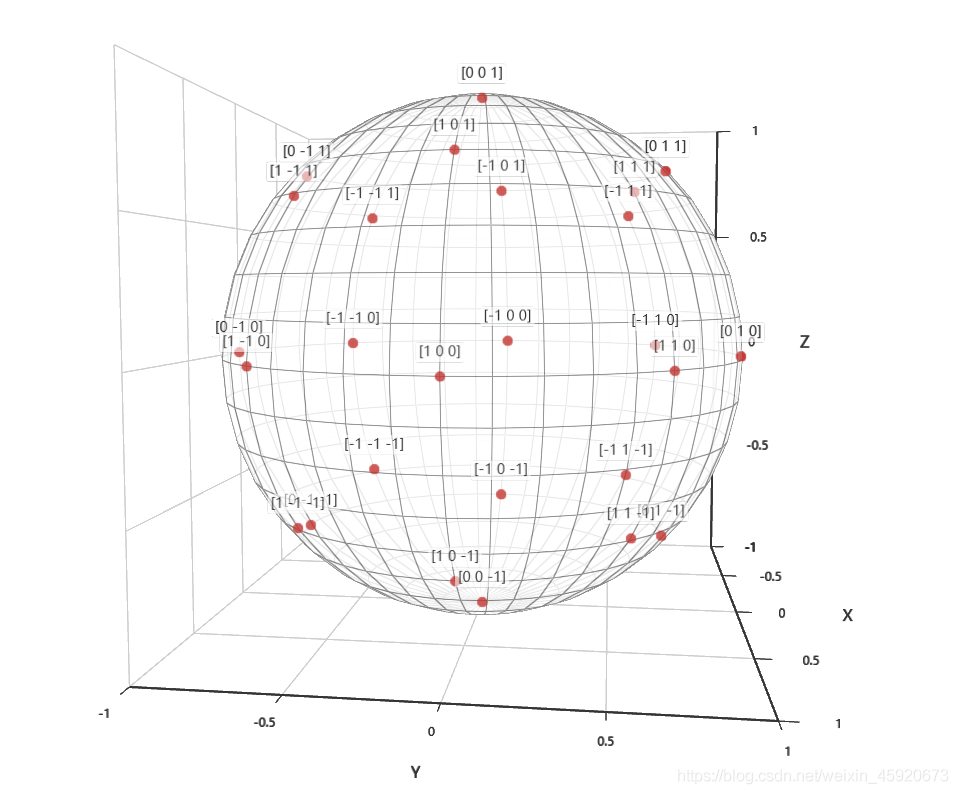因为固体物理书上的球面投影图太难看,就自学 javascipt 用 echarts 做了个可交互的,效果如下: 上面为立方晶系主要晶面(晶向)的球面投影,具体计算代码如下: import mathimport numpy
因为固体物理书上的球面投影图太难看,就自学 javascipt 用 echarts 做了个可交互的,效果如下:


上面为立方晶系主要晶面(晶向)的球面投影,具体计算代码如下:
import math
import numpy as np
def c_scale(A):
A = np.array(A)
n_dim = A.shape[1]; n_size = A.shape[0]
scale2 = np.zeros(n_size)
for j in range(n_dim):
for i in range(n_size):
scale2[i] += A[i,j]**2
scale = scale2 ** 0.5
return scale
def normalize(A): # 二维数组归一化
A = np.array(A)
scale = c_scale(A)
A = np.divide(A.T,scale).T
return A
def cal_point_dict(input_str_list):
points = []; points_dicts = []
for input_str in input_str_list:
input_str=input_str.replace('[',''); input_str=input_str.replace(']','')
try:
data = input_str.split(' ')
point = [] # 求解投影点
for j in range(len(data)):
point.append(int(data[j]))
points.append(point)
except:
data = input_str.split(',')
point = [] # 求解投影点
for j in range(len(data)):
point.append(int(data[j]))
points.append(point)
points_p = normalize(points)
for i in range(len(points_p)):
points_dict={}
points_dict['name']=input_str_list[i]
points_dict['value']=points_p[i].tolist()
points_dicts.append(points_dict)
return points_dicts
# 各晶面指数
input_str_list = ['[0 0 1]','[1 0 0]','[0 1 0]','[0 0 -1]','[-1 0 0]','[0 -1 0]',
'[1 0 1]','[0 1 1]','[1 1 0]','[-1 0 -1]','[0 -1 -1]','[-1 -1 0]',
'[1 0 -1]','[0 1 -1]','[1 -1 0]','[-1 0 1]','[0 -1 1]','[-1 1 0]',
'[1 1 1]','[-1 1 1]','[1 -1 1]','[1 1 -1]',
'[-1 -1 -1]','[1 -1 -1]','[-1 1 -1]','[-1 -1 1]']
points_dicts = cal_point_dict(input_str_list)
points_dicts # 将该数据复制到 球坐标.html 下
绘图 html 源码:
<!DOCTYPE html>
<html style="height: 100%">
<head>
<meta charset="utf-8">
</head>
<body style="height: 100%; margin: 0">
<div id="container" style="height: 100%"></div>
<script type="text/javascript" src="http://img.558idc.com/uploadfile/allimg/210405/1K5092614-2.jpg"></script>
<script type="text/javascript" src="http://img.558idc.com/uploadfile/allimg/210405/1K5094043-3.jpg"></script>
<script type="text/javascript">
var dom = document.getElementById("container");
var myChart = echarts.init(dom);
var app = {};
option = null;
//var data = [{name:'[1 0 0]',value:[1,0,0]},{name:'[0 1 1]',value:[0,1,1]}];
var data1 =
[{'name': '[0 0 1]', 'value': [0.0, 0.0, 1.0]},
{'name': '[1 0 0]', 'value': [1.0, 0.0, 0.0]},
{'name': '[0 1 0]', 'value': [0.0, 1.0, 0.0]},
{'name': '[0 0 -1]', 'value': [0.0, 0.0, -1.0]},
{'name': '[-1 0 0]', 'value': [-1.0, 0.0, 0.0]},
{'name': '[0 -1 0]', 'value': [0.0, -1.0, 0.0]},
{'name': '[1 0 1]', 'value': [0.7071067811865475, 0.0, 0.7071067811865475]},
{'name': '[0 1 1]', 'value': [0.0, 0.7071067811865475, 0.7071067811865475]},
{'name': '[1 1 0]', 'value': [0.7071067811865475, 0.7071067811865475, 0.0]},
{'name': '[-1 0 -1]',
'value': [-0.7071067811865475, 0.0, -0.7071067811865475]},
{'name': '[0 -1 -1]',
'value': [0.0, -0.7071067811865475, -0.7071067811865475]},
{'name': '[-1 -1 0]',
'value': [-0.7071067811865475, -0.7071067811865475, 0.0]},
{'name': '[1 0 -1]', 'value': [0.7071067811865475, 0.0, -0.7071067811865475]},
{'name': '[0 1 -1]', 'value': [0.0, 0.7071067811865475, -0.7071067811865475]},
{'name': '[1 -1 0]', 'value': [0.7071067811865475, -0.7071067811865475, 0.0]},
{'name': '[-1 0 1]', 'value': [-0.7071067811865475, 0.0, 0.7071067811865475]},
{'name': '[0 -1 1]', 'value': [0.0, -0.7071067811865475, 0.7071067811865475]},
{'name': '[-1 1 0]', 'value': [-0.7071067811865475, 0.7071067811865475, 0.0]},
{'name': '[1 1 1]',
'value': [0.5773502691896258, 0.5773502691896258, 0.5773502691896258]},
{'name': '[-1 1 1]',
'value': [-0.5773502691896258, 0.5773502691896258, 0.5773502691896258]},
{'name': '[1 -1 1]',
'value': [0.5773502691896258, -0.5773502691896258, 0.5773502691896258]},
{'name': '[1 1 -1]',
'value': [0.5773502691896258, 0.5773502691896258, -0.5773502691896258]},
{'name': '[-1 -1 -1]',
'value': [-0.5773502691896258, -0.5773502691896258, -0.5773502691896258]},
{'name': '[1 -1 -1]',
'value': [0.5773502691896258, -0.5773502691896258, -0.5773502691896258]},
{'name': '[-1 1 -1]',
'value': [-0.5773502691896258, 0.5773502691896258, -0.5773502691896258]},
{'name': '[-1 -1 1]',
'value': [-0.5773502691896258, -0.5773502691896258, 0.5773502691896258]}]
;
var radius = 1;
option = {
tooltip: {},
xAxis3D: {},
yAxis3D: {},
zAxis3D: {},
grid3D: {},
animation: true,
series: [{
name: '参考球',
type: 'surface',
parametric: true,
// shading: 'albedo',
wireframe: {
show: true
},
shading: 'color',
itemStyle: {
color: [1, 1, 1, 1],
opacity: 0.8
},
parametricEquation: {
u: {
min: -Math.PI,
max: Math.PI,
step: Math.PI / 20
},
v: {
min: 0,
max: Math.PI,
step: Math.PI / 20
},
x: function (u, v) {
return radius * Math.sin(v) * Math.sin(u);
},
y: function (u, v) {
return radius * Math.sin(v) * Math.cos(u);
},
z: function (u, v) {
return radius * Math.cos(v);
}
}
},
{
name: '球面投影点',
type: 'scatter3D',
blendMode: 'darken',
showEffectOn: 'render',
zlevel: 2,
symbol : 'circle',
label: {
show: true,
position: 'top',
formatter: '{b}'},
symbolSize: 10,
data: data1
}
]
};;
if (option && typeof option === "object") {
myChart.setOption(option, true);
}
</script>
</body>
</html>
然而这样画出的图形还不能实现 3D 空间中的遮挡关系,要进一步实现可能还要借助 echarts 的地理坐标功能。
总结
到此这篇关于echarts实现晶体球面投影的文章就介绍到这了,更多相关echarts晶体球面投影内容请搜索易盾网络以前的文章或继续浏览下面的相关文章希望大家以后多多支持易盾网络!
